package, packaging - ![]()
 A package is a wrapped, boxed,
or otherwise contained object.
Packaging is both the material
used in making such containers, and the container itself.
A package is a wrapped, boxed,
or otherwise contained object.
Packaging is both the material
used in making such containers, and the container itself.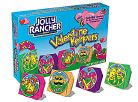
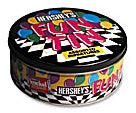 Graphic designers design
packaging, especially their exterior appearance.
Packaging appears everywhere. Ubiquitous in popular
culture, it is found in stores, homes, offices, schools, promising
wonderful products, and as litter for land fills and recycling.
Packaging has been employed as a material in or a subject
of art of numerous genres and styles,
including trompe
l'oeil, collage,
Cubism, Dada, Fluxus,
Arte Povera, and Pop Art.
Graphic designers design
packaging, especially their exterior appearance.
Packaging appears everywhere. Ubiquitous in popular
culture, it is found in stores, homes, offices, schools, promising
wonderful products, and as litter for land fills and recycling.
Packaging has been employed as a material in or a subject
of art of numerous genres and styles,
including trompe
l'oeil, collage,
Cubism, Dada, Fluxus,
Arte Povera, and Pop Art.
Examples:

Japanese, Nintendo, Tomb Raider for Game
Boy Color, 2002, cover on packaging. See anime
and game theory.

American, Hasbro Corporation, All Your Base Are Belong to Us Rayn & Imposter,
2003, printed card and vacuum-formed sheet plastic packaging
of plastic "action
figures." These are dolls of course, but they're known as
action figures when
they're marketed as toys for boys. See the site about "All
Your Base Are Belong to Us."
Also see advertisement, advertising, cardboard, cellophane, corrugated cardboard, costume, ephemera, foil, form, graphic design, ink, label, logo, paper, plastic, preparator, printing, and Styrofoam.
paddle - A flat piece of wood used to beat damp clay, to remove air pockets and consolidate the mass.
page - One side of a leaf, or sheet of paper in a publication, letter, book, or manuscript, often with reference to its contents. "Page" can also refer to a Web page. It is also a common field of reference in graphic design. In a book, the right-hand page is called the recto, the left-hand the verso. These two pages are often arrayed on a signature (a folded sheet of paper) so that it has four pages altogether.
Example:
Andrea Palladio, author; Venice:  Domenico
de'Franceschi, 1570, publisher, I Quattro Libri dell'architettura di Andrea Palladio...,
1570 (4 parts in one volume), printed book;
128 p. : ill., maps ; 12 cm, Metropolitan Museum of Art, NY.
See Palladian.
Domenico
de'Franceschi, 1570, publisher, I Quattro Libri dell'architettura di Andrea Palladio...,
1570 (4 parts in one volume), printed book;
128 p. : ill., maps ; 12 cm, Metropolitan Museum of Art, NY.
See Palladian.
Illustrated:
title page of Andrea Palladio's
I Quattro Libri dell'architettura and engraved portrait
of Palladio from the frontispiece.
Also see bleed, colophon, dyslexia, folio, margin, marginalia, quarto, octavo, rectangle, and signature.

paginate, pagination - To paginate is to number pages. This was first done in 1471 by a German printer. Pagination can be either the assigning of numbers to pages or the designing of a sequential arrangement of pages for a publication.
(pr. PA-jə-nayt, PA-jə-NAY-shən
) Also see align and alignment, book, bookbinding, composition, concatenation, direction, graphic design, juxtaposition, order, periodicity, and signature.
pagoda - A Buddhist tower with several winged eaves; derived from the Indian stupa. Its function is largely to house sacred objects. Such a temple is typically a several-storied tower. From the second and third centuries, pagodas were constructed of wood. During the Song dynasty of the tenth century, Chinese pagodas were built on a tetragonal plan. During the T'ang dynasty, which immediately followed, pagodas were built on an octagonal plan. The number of stories vary greatly, with the height of each story demising regularly from the base to the summit.
(pr. pə-GO-də)
Examples:
![]()

Japan, Pagoda at Horyu-ji Buddhist temple complex,
c. 8th century. See Japanese
art.
China, Pagoda, Northern Song dynasty (960 - 1127 CE), a model made for burial, tri-colored glazed pottery, 98.5 x 30.5 cm, Henan Museum, China. Unearthed at Xinmi, Henan. An inscription on the doors of the pagoda tells us it was made "in memory of Benefactor Qiu Xun on April 28th of the 2nd year of Xianping." Xianping is the title of Emperor Zhen's reign during the Northern Song dynasty.
Also see chinoiserie.
pain - Pain is any of a range of unpleasant sensations any individual may experience. Along with love, fear, angst, and the sublime, it is one of the sensations artists have most frequently attempted to objectify — to represent.
Examples:
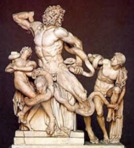
Laocoön and his Sons, Roman copy of a Hellenistic original
from c. 200 BCE,
marble, height
1.84 m, Vatican. Trojan priest Laocoön and his two sons
are attacked at an altar
by giant snakes. Pliny said
it was the work of three sculptors from Rhodes, Hagesandros,
Polydoros, and Athenodoros. The date of the Laocoön is controversial,
some scholars arguing for the late second century BCE,
others for c. 50 BCE.
See Greek, Hellenistic, and Roman art.
Quote:
Also see body art, distort, expression, glisk, incongruity, scarification, senses, sensitivity, sensuality, sentimentality, talent, ugly, and xenophobia.
paint -  Pigment
that is dispersed into a liquid, called a vehicle,
that includes a binder to
make it adhere both to itself
and to the surface to which
it is applied. Many can have a matte,
semi-gloss, or glossy
finish. Types of paint include
tempera, watercolor,
oil paint, gouache, enamel,
encaustic, fresco, lacquer,
oriental lacquer, acrylic,
and secco.
Pigment
that is dispersed into a liquid, called a vehicle,
that includes a binder to
make it adhere both to itself
and to the surface to which
it is applied. Many can have a matte,
semi-gloss, or glossy
finish. Types of paint include
tempera, watercolor,
oil paint, gouache, enamel,
encaustic, fresco, lacquer,
oriental lacquer, acrylic,
and secco.
There
are health hazards associated with the handling of various paints.
They are described on the paint's container, and more fully on
the Material Safety Data Sheet
(MSDS) which can be obtained from the paint's manufacturer.
Also see blot, Duco, filter, ink, painting, painterly, toluene, wash, and xylene.
paint-by-number or paint by number
painterly - A painting technique in which forms are created with patches of color, exploiting color and tonal relationships. The opposite approach is known as linear, in which things are represented in terms of contour, with precise edges.
Examples of painting in this manner:
![]()
Claude Monet (French, 1840-1926), Grainstack,
Sun in the Mist, 1891, oil
on canvas, Minneapolis Institute
of Arts. See Impressionism.

George Wesley Bellows (American, 1882-1925),
Steaming Streets, 1908, oil
on canvas, 38 3/8 x 30 1/4
inches (97.5 x 76.8 cm), Santa Barbara Museum of Art, CA. See
Ashcan school.

Hans Hofmann (American, born Germany, 1880-1966), Simplex Munditis, 1962, oil on canvas, 84 x 72 inches, Santa Barbara Museum of Art, CA. See push and pull.
Works by Rembrandt van Rijn (Dutch, 1606-1669), Robert Henri (American, 1865-1929), and Susan Rothenberg (American, 1945-) are also painterly, while the linear style is typical of paintings by Leonardo da Vinci (Italian, 1452-1519), Charles Sheeler (American, 1883-1965), and Keith Haring (American, 1958-1989).
paisley - A pattern or a fabric figured with a pattern of abstract, curved shapes. The term's origin is in the name of a town in Scotland, famous for its production of textiles.
(pr. PAY-zlee)
Examples:
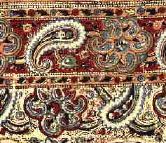
Northern India, a paisley design,
20th century, hand block printed
in five colors with natural dyes
on cotton. In India, the large shapes with the white edges
are called kairi, meaning mango. See mehndi.
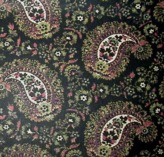
![]()
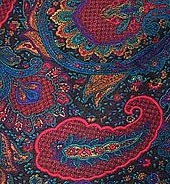
![]()

Also see arabesque and decorative arts.
pale colors - Any tint;
colors having high lightness and low
saturation. When prepared by
mixing pigments, a large amount
of white is mixed![]()

![]()
 with a small amout of a hue.
The opposite of pale colors in their value
— much lighter, but just as low in saturation — are called dark colors. Opposite to pale
colors in saturation — highly saturated, but just as low in lightness
— are called brilliant colors.
Opposite to pale colors in both value and saturation are deep
colors.
with a small amout of a hue.
The opposite of pale colors in their value
— much lighter, but just as low in saturation — are called dark colors. Opposite to pale
colors in saturation — highly saturated, but just as low in lightness
— are called brilliant colors.
Opposite to pale colors in both value and saturation are deep
colors.
Also see aquamarine and pastel.
Paleolithic - The Old Stone Age.
palestra - In ancient Roman architecture, an exercise room.
Also see Roman art.
palette knife - A knife with a spatulate flexible blade, for applying or scraping off a plastic material. There are a variety of types, but the most common are pictured below. The first two on the left have "straight" handles, and the rest have "offset" handles.
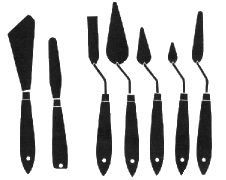
Painters use palette knives for mixing, applying, and cleaning up paints, especially on their palettes, but sculptors find many uses for them too.
Examples of paintings in which paint was applied largely with palette knives:
Paul Cézanne (French, 1839-1906), Portrait of the Artist's Father, c. 1866, oil on canvas, 78 1/8 x 47 inches (198.5 x 119.3 cm), National Gallery of Art, Washington, D.C. Also see Post-Impressionism.
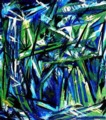
Natalya S. Goncharova (Russian, 1881-1962),
Green
Forest, 1912, oil
on canvas. See Rayonism.

Mikhail Larionov (French, born Russia, 1881-1964),
Rayonist
Composition: Domination of Red, 1912-13, dated on painting
1911, oil on canvas,
20 3/4 x 28 1/2 inches (52.7 x 72.4 cm), Museum of Modern Art,
NY.
Other sites concerned with palette knives:
Also see impasto.
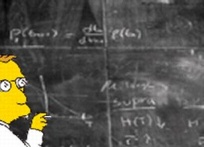 palimpsest - An object
or image that reveals its
history, just as a chalkboard sometimes allows us to see partially
erased marks.
Out of necessity, creating palimpsests was an early method of
recycling. For much of history, writing surfaces
were so rare that they were
often used more than once. When parchment
ran short, many a writer would wash or scrape away an old manuscript to remove old marks,
so that new marks could be made right over them, usually at right angles to the old lettering.
Fortunately for modern scholars erasing was generally ineffective,
because original texts
can frequently be distinguished under the later writing. Any old
objects — for example: ancient
ruins, antique furniture, and battered toys — that
show the effects of their past can be seen as palimpsests, relating
information about their histories. A palimpsest then may be anything
having diverse layers or aspects apparent beneath its surface.
Close examination of a painting's
layers might reveal changes made by the original painter, by later
painters, conservators,
restorers, by environmental
factors, or by vandals.
palimpsest - An object
or image that reveals its
history, just as a chalkboard sometimes allows us to see partially
erased marks.
Out of necessity, creating palimpsests was an early method of
recycling. For much of history, writing surfaces
were so rare that they were
often used more than once. When parchment
ran short, many a writer would wash or scrape away an old manuscript to remove old marks,
so that new marks could be made right over them, usually at right angles to the old lettering.
Fortunately for modern scholars erasing was generally ineffective,
because original texts
can frequently be distinguished under the later writing. Any old
objects — for example: ancient
ruins, antique furniture, and battered toys — that
show the effects of their past can be seen as palimpsests, relating
information about their histories. A palimpsest then may be anything
having diverse layers or aspects apparent beneath its surface.
Close examination of a painting's
layers might reveal changes made by the original painter, by later
painters, conservators,
restorers, by environmental
factors, or by vandals.
(pr. PAL-əmp-sest or pə-LIMP-səst)
Examples:
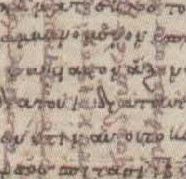
The Archimedes Palimpsest.
(detail
of one page ) This medieval
palimpsest on parchment was discovered in 1899 in a library in
Istanbul. The overlapped
writings on the pages of this book are works of the ancient
Greek mathematician,
engineer, and philosopher, Archimedes (287? - 212 BCE).
In the 10th century a monk in a Greek Orthodox monastery
in Constantinople copied Archimedes'
work from older documents onto these pages. In the 12th
century the parchment was washed and scraped (although only partly
in this case), and religious Christian texts were written at
right angles on top. The religious reasons justifying the reuse
of this parchment included religious intolerance: some Christians
of the time thought it was a holy act to destroy a pagan text and replace
it with a Christian one. The location of the Archimedes Palimpsest
was unknown between 1916 and 1998, when it appeared at auction
at Christies in New York, and was sold on behalf of an anonymous
seller. The man who bought it for two million dollars agreed
to make it available for scholarly research. Although parts of
Archimedes's text in the Palimpsest have been previously
available, some found here are apparently closer to the original,
and some have very important sections not otherwise known to have been preserved.
See scriptorium and xenophobia.

Cy Twombly (American, 1928-), The Italians, 1961, oil,
pencil, and crayon
on canvas, 6 feet 6 5/8 inches
x 8 feet 6 1/4 inches (199.5 x 259.6 cm), Museum of Modern Art,
NY. One of the "second generation" of abstract expressionist painters, art critics have described
Twombly's paintings as akin to painted palimpsests.
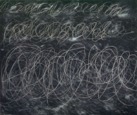
Cy Twombly, Untitled,
1961, oil and charcoal
on canvas, St. Louis Art Museum.
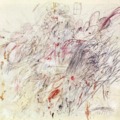
Cy Twombly, Leda and the Swan, 1962, oil,
pencil and crayon
on canvas, 6 feet 3 inches
x 6 feet 6 3/4 inches (190.5 x 200 cm), private collection.
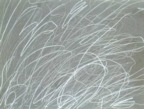
Cy Twombly, Ohne Titel (Roma), 1969, oil
and crayon on canvas.
Also see analogy, eraser, fragment, gemütlichkeit, graffiti, lacuna, marginalia, page, patina, remarque, sgraffito, and x-ray.
Palladian - In the classical architectural style of Renaissance architect Andrea Palladio (Andrea di Pietro della Gondola) (Italian, 1508-1580). Largely an English development of the seventeenth and eighteenth centuries, Palladian architecture is characterized by symmetry and by elaborated adaptation of classical architectural elements.
Examples of Palladio's work:

Andrea
 Palladio
(Italian, 1508-1580), Villa Rotonda (Villa Capra), begun 1567,
general view of exterior, Vicenza, Italy. This building has an
identical portico on each
of four sides.
Palladio
(Italian, 1508-1580), Villa Rotonda (Villa Capra), begun 1567,
general view of exterior, Vicenza, Italy. This building has an
identical portico on each
of four sides. One
of the Villa Rotunda's windows. See fenestration.
 Andrea
Palladio, author; Venice: Domenico de'Franceschi, 1570, publisher,
I Quattro Libri dell'architettura di Andrea Palladio...,
1570 (4 parts in one volume), printed book;
128 p. : ill., maps ; 12 cm, Metropolitan Museum of Art, NY.
See Palladian.
Andrea
Palladio, author; Venice: Domenico de'Franceschi, 1570, publisher,
I Quattro Libri dell'architettura di Andrea Palladio...,
1570 (4 parts in one volume), printed book;
128 p. : ill., maps ; 12 cm, Metropolitan Museum of Art, NY.
See Palladian.
Illustrated:
title page
of Andrea Palladio's I Quattro Libri dell'architettura
and engraved
portrait of
Palladio from the frontispiece.
Also see Neoclassicism.
palladium - A ductile, malleable, tarnish-resistant metal, resembling platinum, used primarily in silver alloys for jewelry.
pallet - A large flat board or box-like construction on which materials may be stored to protect them from damp, and which make them easier to move with a fork-lift. Not to be confused with palette.

palmette - An ornamental motif based on a palm leaf, a radiating cluster of petals. It is often seen in ancient Egyptian and classical Greek ornament.
Examples:

Greece, Antefix decorated with a painted palmette,
from the Archaic temple at Aigira, 500 BCE,
Archaeological Museum of Aigion, Greece. See antefix.

Greece, Funerary stele crowned with a palmette and bearing
the inscription "Timagenes Dionysos", end of
the 4th century BCE,
marble, as is:
88 x 51 cm, Archaeological Museum of Syros, Hermoupolis, Greece.
Also see dingbat.

pamphlet - A brochure
or booklet; a small, thin book, either
bound or unbound. It is usually
 one or more folded
pieces of paper, its usually 6-48 pages defined by the paper's folds and
/ or their edges, and its cover
made of the same or only slightly heavier weight
than that of its pages.
one or more folded
pieces of paper, its usually 6-48 pages defined by the paper's folds and
/ or their edges, and its cover
made of the same or only slightly heavier weight
than that of its pages.
Also see broadside, catalogue, ephemera, handbill, and propaganda.
pan, panning shot - To pan is to rotate a camera about its vertical axis.
Also see cinema, cinematography, fish-eye lens, tilt, tracking shot, video, wide-angle shot, and zoom.
panache - A spirited quality in style or action; verve, dash, flourish. Originally, in French, a bunch of feathers or a plume, such as might sprout from a hat or from a helmet.
(pr. pə-NAHSH)
Also see arms & armor, eccentric, flamboyant, and pretentious.
pantheon and Pantheon - All the gods of a people, or a temple dedicated to all such gods. A particular building is called the "Pantheon" in Rome, although it's actually not certain that this was its ancient function.
(pr. PAN-thee-on)
Images of the Pantheon (the second sense):
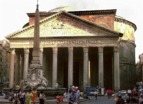
The
Pantheon, Rome, 118 CE. The building consists of a great circular
hall (roofed by a hemispherical
vault), which is entered
by first passing through the pronaos.
All sixteen columns of the
pronaos are monoliths of
Egyptian granite. The pediment was decorated
with reliefs in gilt
bronze as were the internal trabeations of the pronaos. In 609 CE the pagan gods were banished in a ceremony converting the Pantheon to a Christian church — Chiesi di Santa Maria ad Martyres (the Church of Saint Mary and the Martyrs) — and creating All Saints' Day, with the following day becoming All Souls' Day — also known as Halloween. As the burial place of royalty and many great artists — including the Renaissance master Raphael (Raffaello Sanzio, 1483-1520) — the Pantheon is a national monument and a miracle of architecture. See portico.

Interior view of the Pantheon. At the top of the Pantheon's coffered dome is its
oculus. In this photo, sunlight projects through this open hole to the sky. There has never been any glass or other cover for this opening. Anticipating the rains, the Romans placed twenty-two small drains in the floor, which continue to function well today.

Heneage Finch, Fourth Earl of Aylesford (English,
1751-1812), Interior of the Pantheon, Rome, pen
and ink and watercolor on paper,
26.4 x 18.3 cm, Tate Gallery, London.
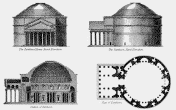
English, from the encyclopedia, 1897: Four views
of the Pantheon: front elevation, flank elevation, cross-section,
and floor plan, late 19th century, engraving. See cross-section,
elevation, and plan.
Also see architecture and Roman art.
pantograph - A device for copying a two-dimensional figure to a desired scale, consisting of styluses for tracing and copying mounted on four jointed arms in the form of a parallelogram with extended sides. Leonardo da Vinci (Italian, 1452-1519) used one. Pantographs are based on the simple principle of the parallelogram in Euclidean geometry understood 2300 years ago. The artist moves a pointer attached to one part of the pantograph along the outline of the original image, and a pencil attached to another part copies the image at either the same size, larger or smaller. The placement of the pointer and pencil determines the overall scale.The one Thomas Jefferson (American, 1743-1826) devised and used to copy letters as he wrote them can be seen at his Monticello home. Such tools have been made largely obsolete by photographic and other technologies, but are great for studying scale.
Examples:

American, Sorenson's Engraving Pantograph, an engraving of
one in use by the U.S. Coastal Survey, published as Fig. No. 27, Report of
Superintendent, 1867, Historic
C&GS Collection, National Oceanic and Atmospheric Administration
Central Library, Washington, DC.
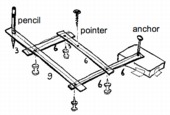
An easily improvised pantograph. Cut narrow
strips of cardboard or of
wood using the dimensions
in this diagram. It's okay
to make your dimensions different from these if you'd like to
see how to modify the scale
of your copyies. If you experiment with various changes in these
measurements you'll learn more about how to alter the scale.
You'll also need four push-pins, a pencil,
a screw, a nail, a small block of wood,
and some adhesive tape.
See caliper, drawing, pantograph, pointing and pointing machine, and proportion.
Pantone Matching System (PMS) - A color
matching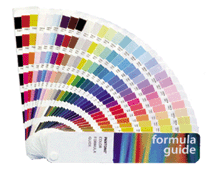 system
developed by the Pantone,
Inc. Based on 14 standard Pantone basic mixing colors, it
includes over 1000 different shades. The Pantone Color Formula
Guide is the printers' guide to the Pantone Matching System, representing
shades on both coated or uncoated stock, along with the precise
printing formulas to achieve each color. The fan format guide
makes it easy to select colors and check printed colors against
a recognized and achievable standard. The Pantone Color Formula
Guide is the essential color reference tool for printers, and
should be replaced by new book every year to maintain accurate
color communication.
system
developed by the Pantone,
Inc. Based on 14 standard Pantone basic mixing colors, it
includes over 1000 different shades. The Pantone Color Formula
Guide is the printers' guide to the Pantone Matching System, representing
shades on both coated or uncoated stock, along with the precise
printing formulas to achieve each color. The fan format guide
makes it easy to select colors and check printed colors against
a recognized and achievable standard. The Pantone Color Formula
Guide is the essential color reference tool for printers, and
should be replaced by new book every year to maintain accurate
color communication.
Also see CMYK, color correction, color look-up table, color management systems, color permanence, color separation, color scheme, color space, color temperature, color wheel, dynamic range, and RGB.
paper-maché - See papier-mâché or papier mâché.
papermaking - The basic papermaking proces takes advantage of the ability of plant cell fibers (cellulose) to adhere to each other when a watery pulp made from the fibers is spread on a screen called a deckle, and dried. Today, paper is made principally from wood pulp combined with pulps from waste paper or, for fine grades of paper, with fibers from cotton rags. For newsprint, tissues, and other inexpensive papers, the pulp is prepared mechanically, by grinding the wood, sometimes boiling it with various chemicals. The pulp is poured onto a deckle, where the water drains away and the fibers begin to mat. The paper layer then passes through a series of rollers that dry, press, and smooth it, and add various finishes.
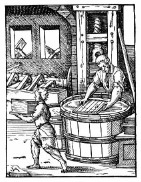
German, A man making paper, works pulp on a deckle, as
a child carries a stack of the final product, 17th century,
woodcut. Through two windows
see paddle wheels that power the production of pulp. Even today,
most large commercial papermills are sited beside rivers.
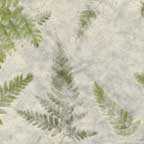
![]()

![]()
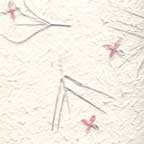
Other resources concerning papermaking:
Also see calendering, mold, and vellum.
papier-collé - A type of collage in which paper shapes are combined into one work of art. French, literally "stuck paper."
(pr. PAH-pee-ay kə-LAY)
Examples:

Diego Rivera (Mexican, 18), Still Life with Bottle, 1914, drawing with pencil,
papier-collé and gouache
on paper, 35.5 x 19 cm, government
of Veracruz, Mexico. Among the papers Rivera used is some wallpaper. See Mexican
art.
Juan Gris (born "Jose Victoriano Gonzales Perez") (Spanish, 1887-1927), Fruit Dish and Carafe, 1914, oil, papier-collé and charcoal on canvas, 92 x 65 cm, Rijksmuseum Kroller-Muller, Otterlo.
papier-mâché or papier mâché - A material, made from paper pulp or shreds of paper mixed with resin, wallpaper paste, or flour and water (2:1 by volume), which can be molded or modeled into various shapes when wet and becomes hard and suitable for painting and varnishing when dry. Other substitutes (less likely to mold or mildew) are white glue and water, liquid starch and water, and methyl-cellulose paste and water (one 2 oz. package per gallon of water).
Papier-mâché's permanence is relative of course, but its light weight, minimal expense and the ease of its making recommend it for many uses.
Celluclay is a powdered-paper product for making papier-mâché.
Papier-mâché is a French word, literally meaning chewed-paper. The equivalent Italian term is carta pesta. It is known to have been used for low reliefs in Italy in the fifteenth century, and was occasionally popular in Europe for ornamental furniture, etc.
Papier-mâché is almost always formed on an armature. An extraordinary variety of free and inexpensive things can serve. Consider cardboards of any type, cut, folded or curled and taped together with any combination of wood, wire, crumpled paper, Styrofoam, and pieces of scrap plastic packaging.
To slow mold in wallpaper paste or flour and water paste, add 3 tablespoons sugar per gallon. Also helping to retard spoilage is a teaspoon of salt per batch.
(pr. American: PAY-pər mə-SHAY), French: PAH-pee-YAY mə-SHAY)
|
Starting with a balloon's form Tear strips of newspaper (1-2 inches wide by 2-4 inches long) and, one at a time, dip them into a bowl of prepared paste, applying each to the surface of a balloon. Overlap about 3 or 4 layers, alternating layers-- one of newspaper and one of paper bags or paper towels-- in order to see that each layer is completed. Spread the paste onto each completed layer instead of dipping and wiping each piece of paper. Let this dry, then pop the balloon. Use the result as the starting point for a mask, a sculpture, etc., painting the final form. Forming pulp into a small sculpture Tear paper into pieces about 1/2 inch square, or obtain what is produced by a "paper shredder" -- often used in offices that must destroy sensitive documents. Each participant will require enough such pieces to pack at least a cup measure. Place the torn paper in a container and cover with water and stir it to make sure all the paper becomes wet. Add a teaspoon of salt to retard spoilage. After letting this soak at least two days, mix and squeeze by hand until it becomes a pulp. Mix in one of the adhesive substances noted above, preparing only the amounts of pulp needed. Now model or mold this mixture into the forms you wish to produce. Allow to dry thoroughly. Finish surfaces with any type of paint, small objects, etc., and varnish.
|
Examples:
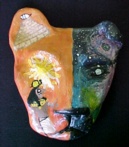
Lindsey Haché (Canadian high school student), Mask, papiér-mâché, fall of 2000, Lower Sackville, Nova Scotia. This feline head reveals the artist's interest in Egyptian art and in contrasting day and night-time imagery.
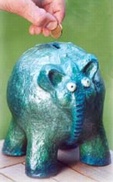
Ellen Carlier (Belgian, contemporary), Blue Elephant, a coin bank,
height 20 cm (7 1/2 inches), pulp over a latex balloon, acrylic paints, and varnish, collection of the artist.
Related links:

papyrus -  An ancestor to modern papers,
An ancestor to modern papers,
papyrus was used especially by the ancient
Egyptians, Greeks and Romans. A papyrus can also be a document or drawing produced on papyrus. The plural form of the word is papyri. Sheets of papyrus were made from stems of the
papyrus plant, which is native almost exclusively to the delta of Egypt's Nile River, which made it an important trading commodity in the Mediterranean region. It is possible for students to use specimens of this plant to produce their own sheets: cutting the stems length-wise, flattening them, overlapping them side-by-side, and again overlapping a second such layer perpendicular to the first. The dry climate of Egypt has made it possible for papyri to remain largely intact, in many cases, for two, three, or more millennia.
(pr. pə-PI:-rəs)
Examples:

Egypt, Western Thebes, Section from the "Book of the Dead"
of Nany, c. 1040-945 BCE,
Dynasty 21, reigns of Psensennes I-II, Third Intermediate period,
painted and inscribed papyrus,
height of illustrated section
13 3/4 inches (34.9 cm), Metropolitan Museum of Art, NY.
Egypt, second-first centuries BCE (Ptolemaic Period), Fragment of a Book of the Dead Belonging to Paheby, Son of Ankhpakhered and Takhebyt, paint and black ink on papyrus, 8 x 11 1/4 inches (20.3 x 28.5 cm), Michael C. Carlos Museum. See fragment.
Papyrus is made from the pith or stems of a tall, aquatic plant, called Mediterranean sedge, also known as Egyptian paper rush and paper plant. The plural form can be either papyruses or papyri. (pr. pah-pi:'rus)
Other resources concerned with papyrus:
Also see Egyptian art, hieroglyphics, palette, and rush.
 parabola
- A plane curve
formed by the intersection of a right circular
cone and a plane parallel
to an element of the cone. A plane curve formed by the locus of
points equidistant from a
fixed line and a fixed point
not on the line. (pr. pə-RA-bə-lə)
parabola
- A plane curve
formed by the intersection of a right circular
cone and a plane parallel
to an element of the cone. A plane curve formed by the locus of
points equidistant from a
fixed line and a fixed point
not on the line. (pr. pə-RA-bə-lə)
Related links:
Also see arc, cone, cylinder, ellipse, hyperbole, mathematics, parabola, and sphere.
paradichlorobenzene
- A crystalline compound used as a fumigant
for moths and larvae. These pests are notorious for their destruction of various fibers. See art
conservation.
paradigm - An example that serves as a pattern, an exemplar, or a model.
(pr. PAY-rə-di:m)
Also see paradigm shift.
paradigm shift - When one era shifts into another, the habits of the earlier one are disrupted by new ones which eventually settle into a familiar routine. The phrase is used to describe any sort of major shift of mind-set or world-view. For example, the change from pre-modern to modern art was effectively a change from a paradigm in which paintings were seen as windows through which one looked, as in Renaissance and Baroque illusionism — to a new paradigm of abstraction. Similarly, the change from modernism to postmodernism is now commonly viewed as a paradigm shift.
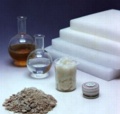
paraffin or paraffin wax - White or colorless flammable oil or wax obtained in the distilling of petroleum. Paraffin is often used as a material for modeling and in such wax-resist techniques as batik, either as a substitute for beeswax, or as a supplement to it.
(pr. PA-rə-fən)
paragone - From the Italian for "comparison", this is a critical term referring to the debate begun in the 16th century and continued in the 17th about the relative merits of painting and sculpture.
Also see illusion.
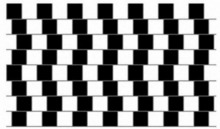 parallel
- Two or more straight lines or edges
on the same plane that do
not intersect. Parallel lines have the same direction.
parallel
- Two or more straight lines or edges
on the same plane that do
not intersect. Parallel lines have the same direction.
This illustration
is a field of horizontal
lines — all parallel to each other. A staggered pattern of black and white squares
is arranged in such a way
that the viewer's perception
causes him/her to doubt that they are parallel. Our eyes perceive
diagonal lines at varied angles. This is one of many possible
optical illusions.
Also see butt, corrugate, kerf, point, counterpoint, and mathematics.
parallelepiped - A polyhedron with six faces, each a parallelogram, and each parallel to its opposite face. A regular hexahedron is a type of parallelipiped.
(pr. PAY-rə-LE-lə-PI:-ped)
Also see mathematics, polygon, rhombohedron, and vertex.
 parallelogram - A four-sided polygon,
all opposite sides being parallel
to each other. An equilateral
parallelogram is called a rhombus.
parallelogram - A four-sided polygon,
all opposite sides being parallel
to each other. An equilateral
parallelogram is called a rhombus.
Also see geometric, mathematics, pantograph, parallelepiped, quadrilateral, rectangle, rhombohedron, square, trapezium, and trapezoid.
parameter - A factor that either restricts what is possible or what results, or determines a range of variations. In mathematics, a parameter may be a constant value in an equation that varies in other equations of the same general type, especially such a constant that describes a curve or surface, such that changing it changes the curve or surface in some way. It may also be a variable that stands for the coordinates of a point. And, in other sciences, a parameter may be one of a set of measurable factors — such as temperature, volume, color, or acidity — that define a system and determine its behavior.
paraph - In a signature, a final squiggle or flourish. Although it may seem to have resulted simply from flamboyance, its original function, during the Middle Ages, was to discourage forgery.
Examples:

Queen Elizabeth I (English, 1533-1603). These signatures present several paraphs. Elizabeth I was famous for her refined penmanship. Her pretty paraphs remind us why she was called not only as "Good Queen Bess" and "The Virgin Queen," but also "Her Paraphine Highness." [Just kidding about the last nickname: a double entendre which would imply that Elizabeth had waxen qualities. Judging from some portraits, this might not be far from the truth!]

Benjamin Franklin (American, 1725-1802).
parasol - An umbrella atop a Chinese pagoda; a vestige of the chatra on an Indian stupa.
parchment - An ancestor to contemporary paper, parchment is a material on which to write or paint prepared from the skin of a sheep or goat. It replaced the use of papyrus during the ancient Roman period. Monastic scribes of the Middle Ages practically monopolized its use in Europe preceding the introduction there of papermaking techniques utilizing plant fibers in the twelfth and thirteenth centuries. Parchment may also refer to paper made in imitation of this material.
Examples of works on true parchment:

Petrus Christus (Netherlandish, active by
1444, died 1475/76), Head of Christ, c. 1445, oil
on parchment, laid down on wood,
overall 5 7/8 x 4 1/4 inches (14.9 x 10.8 cm), parchment 5 3/4
x 4 1/8 inches (14.6 x 10.5 cm), Metropolitan Museum of Art,
NY. See miniature.
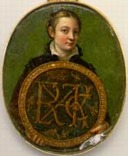
Sofonisba Anguissola (Italian, c. 1535-1625),
Self-Portrait, c. 1555, oil
on parchment, 3 1/4 x 2 1/2 inches (8.2 x 6.3 cm), Museum of
Fine Arts, Boston. The artist
holds a medallion inscribed
in Latin around the rim: "The maiden Sofonisba Anguissola,
depicted by her own hand, from a mirror, at Cremona." Inside
the circle is a cryptogram whose
entwined letters are included
in the name of Anguissola's father, Amilcare. The meaning
and original purpose of this enigmatic portrait remain a mystery. See Baroque, circle,
cryptic, feminism
and feminist art, miniature,
mirror, oval,
and self-portrait.
Related link:
Also see bristol board, illustration board, incunabulum, oaktag, scroll, and vellum.
parergon - A part of a work of art which is secondary to the main subject or theme of its composition, such as a still life or landscape which is a detail within a portrait. Also used to refer to a work made by anyone working at another sort of job or profession, when made either apart from or as a part of their work, as would be a criminologist's drawing of the scene of a crime.
parget - Ornamental work in plaster.
Also see gesso.
(pr. PAHR-jət)
parody - A work that imitates the characteristic style of another work, either for comic effect or ridicule. Parody is one of the basic tropes.
Examples:

American, Voting for Dummies, 2000, a mock book-cover
satirizing the causes of the
contested US presidential election of 2000, as it parodies the
series of for Dummies books, 1990s-the present. See text.

![]()

American, Apple iPod, 2004. A poster, and a still from an iPod TV commercial showing a grid of posters for Apple's MP3 player on an exterior wall.
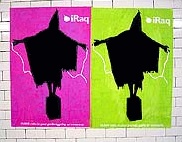
A parody that replaces the silhouette of the iPod user with one of the hooded torture victims of Iraq's Abu Ghraib prison. It substitutes the original text "iPod" with "iRaq." This political / human-rights protest poster was placed in a New York City subway station in June, 2004. Similar posters can be downloaded from forkscrew.com.
Also see appropriation, content, caricature, homage, irony, and satire.
parquetry - Inlay or veneers of wood forming a geometric design; as related to marquetry, which forms a pictorial image. It is most commonly seen in parquet floors.
(pr. PAHR-kə-tree)
Examples:
![]()

![]()

![]()

![]()
Details of three parquet floors.
Charles Le Brun and Jules Hardouin-Mansart (French architects), Galerie des Glaces (Hall of Mirrors), 1678-1684, 10.5 x 12.3 x 73.0 m, Pallace of Versailles. See coffer and mirror.
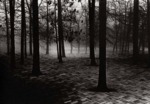
Scott Mutter (American, 1944-), Untitled (Forest), 1975, gelatine-silver
print photomontage, 11 x 14
inches, American
Museum of Photography. This forest has a parquet floor.
parsemage - A method of making an image by scattering dust from charcoal or colored chalk on water and then skimming the design off by passing a stiff paper or cardboard just under the water's surface. Parsemage was invented by surrealist Ithell Colquhoun.
(pr. PAHR-sə-MAHZH)
Also see aleatory and aleatoric, bricolage, collage, coulage, découpage, femmage, frottage, fumage, marouflage, montage, and photomontage.
Parthian art - See Mesopotamian art
parting agent or parting compound - See release agent.
https://inform.quest/_art